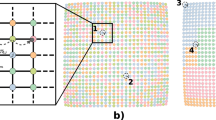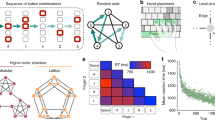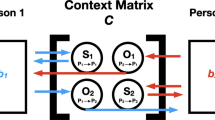Abstract
Arising from: J. G. Oliveira & A.-L. Barabási Nature 437, 1251 (2005); Barabási & Oliveira reply.
A stochastic queue model of human behaviour developed on the basis of the distribution of timing of tasks, as studied in a sample of e-mail messages at a university1 and in the written correspondence of Albert Einstein2, may not be as simple as it seems. Although this model reproduces the apparently non-Poisson distribution of correspondence delays, its interpretation is more complicated than suggested by Barabási, who claims that humans execute their tasks based on some perceived priority, setting up queues that generate very uneven waiting-time distributions for different tasks1. Such an explanation is intuitively appealing in the context of the queue metaphor, but does not exclude other mechanisms. By attributing delays in the correspondence to task priorities, this explanation ignores two important classes of mechanism that also contribute to the apparent distributions of task timings: the semantic content of an individual's correspondence and the social context in which this correspondence occurs.
Similar content being viewed by others
Main
For example, Oliveira and Barabási use Albert Einstein's two-year delay in correspondence with Theodor Kaluza as an illustration of the ‘priority list’ model2. Although it is true that Einstein did not communicate Kaluza's work to the Prussian Academy of Sciences until two years after Kaluza first sent his manuscript to Einstein, this was not due to a perceived unimportance of the task by Einstein. Rather, on 21 April 1919, Einstein wrote a prompt reply acknowledging the receipt of Kaluza's manuscript just a few days earlier3. On 29 May 1919, Einstein suggested that Kaluza should revise his current manuscript to resolve a flaw in his unified field theory, and encouraged Kaluza to submit the work for publication in Mathematische Zeitschrift, even offering “to put in a good word” with the editors3. To help Kaluza, he enclosed a manuscript of his own that related the electromagnetic and gravitational fields4.
Kaluza attempted to address the flaw pointed out by Einstein, but ultimately was unable to, referring to it as a “serious difficulty” in the final version published in 1921 (ref. 5). Thus, the delay between Einstein's receipt of Kaluza's original manuscript and its final publication was probably due to the difficulty that Einstein's question posed for Kaluza, and not to the low priority that Einstein assigned either to replying to Kaluza or in recommending his manuscript for publication.
Even when questions posed in letters are easy to answer, responses and their consequent actions may be delayed because they are part of a many-person conversation and require information from other interlocutors. For example, the distribution observed for e-mail delays1 may be due to groups of individuals engaging in shared conversations, in which individuals send messages not according to personal priorities, but rather to their collective attributes such as kinship, hierarchy and affiliation. Earlier analysis of the e-mail data set used by Barabási revealed significant many-person conversations, as reflected in the temporal coherence of three-person e-mail exchanges6. These social structures and their temporal correspondence properties were due to groups of individuals who were affiliated with academic departments, comprised non-academic committees, and shared common foreign nationalities6. Their existence is consistent with the idea that the mechanism underlying the apparent non-Poisson distribution of e-mail timings is related to the collective properties of the inherently social groups that produce them.
In all communications, both the semantic content of tasks, as in the correspondence between Einstein and Kaluza, as well as their social context, as in the correspondence of e-mail users, are important factors in the mechanics of human interaction. The stochastic queue provides a useful model and an elegant metaphor for the interdependence of human tasks, but this does not mean that it is determined by individual priority lists. Indeed, the priority queue metaphor could be replaced by a semantic ladder or social web, depending on the nature of the variable (personal priority, task difficulty or social relevance, respectively), that parameterizes the model's response time. Determination of the mechanism(s) underlying the apparent distribution of human task timings requires precise investigation of the relationships among the semantic content of tasks, task priorities as perceived by individuals, and the collective attributes of the social groups that govern human behaviour.
References
Barabási, A. L. Nature 435, 207–211 (2005).
Oliveira, J. G. & Barabási, A. L. Nature 437, 1251 (2005)
Einstein, A. The Collected Papers of Albert Einstein (Princeton Univ. Press, Princeton, New Jersey, 1987).
Einstein, A. Sitzungsberichte der Preussischen Akademie der Wissenschaften 349–356 (1919).
Kaluza, T. Sitzungsberichte der Preussischen Akademie der Wissenschaften 54, 966–972 (1921).
Eckmann, J. P., Moses, E. & Sergi, D. Proc. Natl Acad. Sci. USA 101, 14333–14337 (2004).
Author information
Authors and Affiliations
Rights and permissions
About this article
Cite this article
Kentsis, A. Mechanisms and models of human dynamics. Nature 441, E5 (2006). https://doi.org/10.1038/nature04901
Published:
Issue Date:
DOI: https://doi.org/10.1038/nature04901
This article is cited by
-
Communication activity in a social network: relation between long-term correlations and inter-event clustering
Scientific Reports (2012)
-
Mechanisms and models of human dynamics (Reply)
Nature (2006)
Comments
By submitting a comment you agree to abide by our Terms and Community Guidelines. If you find something abusive or that does not comply with our terms or guidelines please flag it as inappropriate.



